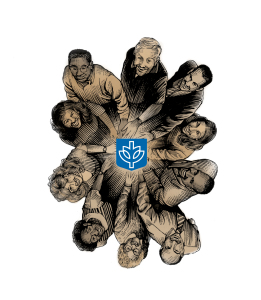 Faculty have taken full advantage of the university’s innovative intercollege grant program, and the resulting research is as interesting and diverse as the collaborators themselves.
Faculty have taken full advantage of the university’s innovative intercollege grant program, and the resulting research is as interesting and diverse as the collaborators themselves.
By definition, an expert is one because of the specific knowledge he or she possesses. Immersion in a field of study is how faculty advance their careers and how colleges advance their standing. This structure has many benefits, but it has one large drawback—many of today’s thought-provoking and important questions don’t fit into just one box. Collaboration among experts in different fields is often necessary to make breakthroughs that advance knowledge and practice.
To encourage the flow of ideas, DePaul faculty and staff hit upon an innovative approach to research. The Office of Academic Affairs launched the Innovation through Collaboration Initiative in 2014 to connect faculty across disciplines and stimulate opportunities for collaboration and innovation. Part of the initiative is a grant program for research projects that involve faculty from multiple colleges.
So far, the initiative has funded 18 projects across three grant categories: the Provost’s Collaborative Research Fellowship Program ($20,000 award), Collaborative Research Grants ($5,000 award) and Collaborative Instruction Fellow Stipends ($4,000 award). Here is a closer look at five of the 18 funded projects that amply demonstrate how faculty reaching across disciplines have found that they really can work better together.
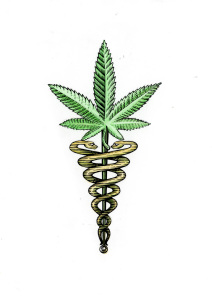 Healthy Discussion About Medical Marijuana
Healthy Discussion About Medical Marijuana
For patients with chronic diseases who often endure the debilitating side effects of life-saving drugs, a prescription for medical marijuana can be the difference between staying alive and actually living. However, the laws concerning marijuana use differ greatly from state to state, and therefore, talking with health care providers about it can
be difficult.
“The legal status of both recreational and medical marijuana is changing across the states,” says
Douglas Bruce, assistant professor in the
Department of Health Sciences. “The
Affordable Care Act promotes open communication between patients and health care providers when managing chronic disease, and there are guidelines for doing so. But when it comes to cannabis use, these guidelines just aren’t there.”
Bruce’s earlier research explored how young people with HIV use marijuana to alleviate the side effects of antiviral medication and to cope with stressors they might experience. Bruce approached Associate Health Communication Professor
Elissa Foster and Mona Shattell, former professor and associate dean for research and faculty development in the
College of Science and Health, to collaborate on a common goal: exploring patient/provider communication regarding the use of marijuana for those with chronic diseases. The professors created their grant proposal, “Patient and Primary Care Provider Perspectives on Recreational and Therapeutic Cannabis Use Within a Changing Sociocultural and Political Context.” Their application was successful. “The collaboration grant will help us gain insights that will hopefully contribute to establishing actual guidelines for these discussions,” Bruce says.
Bruce, Foster and Shattell will interview nurse practitioners and patients to produce data that will help them identify best practices for these discussions. Ideally, they’d like to talk with people from a variety of backgrounds, socioeconomic conditions and geographic locations with varying marijuana laws.
“Our questions will get to both the providers’ and the patients’ attitudes and practices,” Bruce says. “Having a team of researchers from different academic backgrounds collaborating on the research will provide a broader, multidisciplinary view on the issues. This grant allowed us to step outside of our silos, and I’m not sure that would have happened without encouragement from the university. We’re grateful for the support.”
 Reduce, Reuse, Educate
Reduce, Reuse, Educate
According to the
Intergovernmental Panel on Climate Change, the
American Meteorological Society, the
American Chemical Society and numerous other organizations, while the earth’s climate has undergone numerous changes throughout history, current global warming is occurring at an unprecedented rate. Today’s changes likely are accelerated through human activity and are not expected to slow anytime soon. Regardless, with the rising temperatures comes an increased need for professionals knowledgeable in handling climate change policy on the city, state and national levels. The creation of an interdisciplinary minor in climate change science and policy seemed like a natural next step to several faculty members.
“Climate change is one of these issues that you have to engage with multiple disciplines if you want to have a complete understanding,” says
Hugh Bartling, a
public policy studies associate professor who is developing the new minor with
Mark Potosnak, an
Environmental Science and Studies associate professor. “If the science is accurate—and we believe that it is—climate change will affect many industries, from agriculture to business and finance.”
As the minor is being developed, the professors are meeting with faculty across the university to ensure that it is accessible to students from all colleges. In this way, the collaboration grant has brought together not only faculty from different colleges, but also students who can share their varied perspectives with their classmates.
“Businesses are going to need to communicate their own environmental policies, and so they will need communication professionals who understand the science,” Bartling says. “Some cities, such as
Evanston, [Ill.,] have already created positions for people who can contribute to sustainability policy. The applications are more and more numerous, and DePaul is one of few universities responding to that change. This minor will help prepare and give our students an edge in these new professional opportunities that might have huge impacts on our world.”
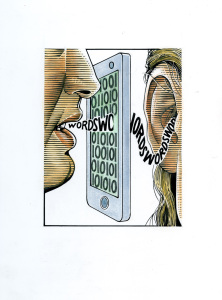 The Nexus of Communication and Coding
The Nexus of Communication and Coding
As the overlap of communication and technology increases, so does the need for professionals who understand both of these disparate fields. Associate Professor of Relational Communication
Tim Cole and Associate Professor of Information Systems and Associate Dean of the
Jarvis College of Computing and Digital Media (CDM)
Theresa Steinbach (CSH ’88, MBA ’90, CDM MS ’99, PhD ’08) are interested in closing this communication chasm through their interdisciplinary class, Communication, Coding and Entrepreneurship.
“By teaching this class, our students will have a better understanding of where the other side is coming from,” Steinbach says. “We want to give them a leg up on that learning curve so that when they’re in the workplace, they’ll be better able to work with people who think differently.”
Enrolled College of Communication (CMN) and CDM students will be paired together to conceptualize and execute web-based or mobile apps to solve a communication problem. For the first half of the course, each class will be divided into three parts: during the first hour, Steinbach will teach the CMN students basic coding, while Cole will teach the CDM students foundations of communication theory. In the second hour, the students will come together to learn about entrepreneurship from the professors, who are both entrepreneurship fellows with the Coleman Fellows Program. In the last hour, students will work in teams on their apps. The second half of the course will focus mainly on testing and finishing the apps.
“Communication students have a lot of ideas for solving problems but often lack the knowledge to execute them; CDM students know how to execute, but they usually need that client to propose the idea,” Cole says. “Getting these two sets of students to work together will provide a real-world opportunity that will benefit their future careers.”
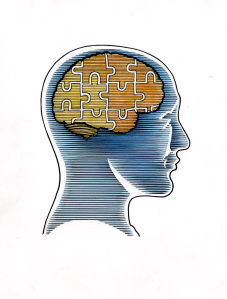 Brain Puzzles
Brain Puzzles
From the first time Vincent de Paul Professor of Biological Sciences
Dorothy Kozlowski and Health Sciences Assistant Professor
Eiron Cudaback discussed their research, the opportunity for innovation and collaboration was obvious. “One of the first things I did after being hired was call up Dorothy and say, ‘I actually have this really interesting idea for research for us,’” Cudaback says.
Cudaback’s research focuses on the
apolipoprotein E gene (APOE) and its protein product and how they influence brain inflammation. There are three common APOE variants in the global population, and the type you have might indicate an increased risk for neurodegenerative diseases such as Parkinson’s and Alzheimer’s. Kozlowski’s research focuses on the way a person’s brain responds to traumatic brain injury (TBI), which increases the likelihood of developing these diseases. The catch: Researchers are unsure why they’re predictors.
“The one thing that links APOE to degenerative diseases is the same thing that links TBI to the same diseases—the presence of
neuroinflammation,” Kozlowski explains. “Both APOE and TBI play a role in, or induce, neuroinflammation.
The intersection led to two research questions: First, does the particular APOE variant one person has accurately predict how smoothly he or she will recover from a TBI, if at all? Secondly, why or why not might it be a predictor?
“By dissecting the how and why, we can identify new molecular targets that may be important in therapeutic intervention,” Cudaback says. “The idea is that if someone sustains a concussion, we could use research like this to know how to help or treat them based on their APOE genotype. The research could eventually have a wide-reaching effect, from a young kid interested in playing football to the U.S. Department of Defense.”
For their collaboration, Kozlowski will research whether the type of APOE variant present affects the brain’s reaction to and recovery from a TBI, and Cudaback will then take a closer look at the mechanisms of the inflammation on a molecular and cellular level. “Just in writing the grant, we established that there’s so much we’d like to do in parallel and after this initial research,” Cudaback says. “This collaboration grant is going to give us the ability to gather data and to demonstrate that this can really work so we can take it even further,” Kozlowski adds. “It’s a long road from the bench to clinical application, but we’re starting to form the building blocks.”
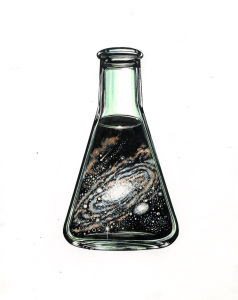 Answering the Unanswerable
Answering the Unanswerable
A philosopher and a physicist discuss the origin of the universe—it sounds like the setup to a classic joke, but it is a common occurrence for Philosophy Professor and Director of the
DePaul Humanities Center
H. Peter Steeves and Associate Professor and Chair of the
Physics Department
Jesús Pando. “Many years ago, Peter and I invited professors from different disciplines to discuss time and space and things like that,” Pando says. “The group disbanded, but Peter and I continued our discussions and eventually boiled it down to, ‘How can something arise from nothing?’ and ‘How did the universe begin?’”
Pando and Steeves decided to formalize their discussions and successfully proposed their project, “Cosmology Meets Continental Philosophy: Natural Laws and Why There Is Something Rather Than Nothing,” for a collaboration grant. They are using their grant to further their research and to send Steeves to a conference where he will present their data and look to create further collaborative relationships for the team.
“Jesús is trying to understand and apply the philosophy, and I’m trying to do the same with the physics so we can really see how the two work in tandem,” Steeves says. “Hopefully the combination will get us some answers to this question that I think each of our disciplines shares at heart.”
Although they are tackling perhaps the biggest question of existence, Steeves and Pando are serious about their research and about working toward a concrete answer. Steeves believes that through their collaboration he and Pando might eventually answer the seemingly unanswerable. Pando is hopeful, but reticent about his expectations.
“Peter is, perhaps, a bit more optimistic than I,” Pando admits. “But I do think we’ll find out if the question is legitimate. As a result of our collaboration, I’m doing physics more rigorously, and Peter is doing philosophy more rigorously. That can only bring us closer to the answer.”